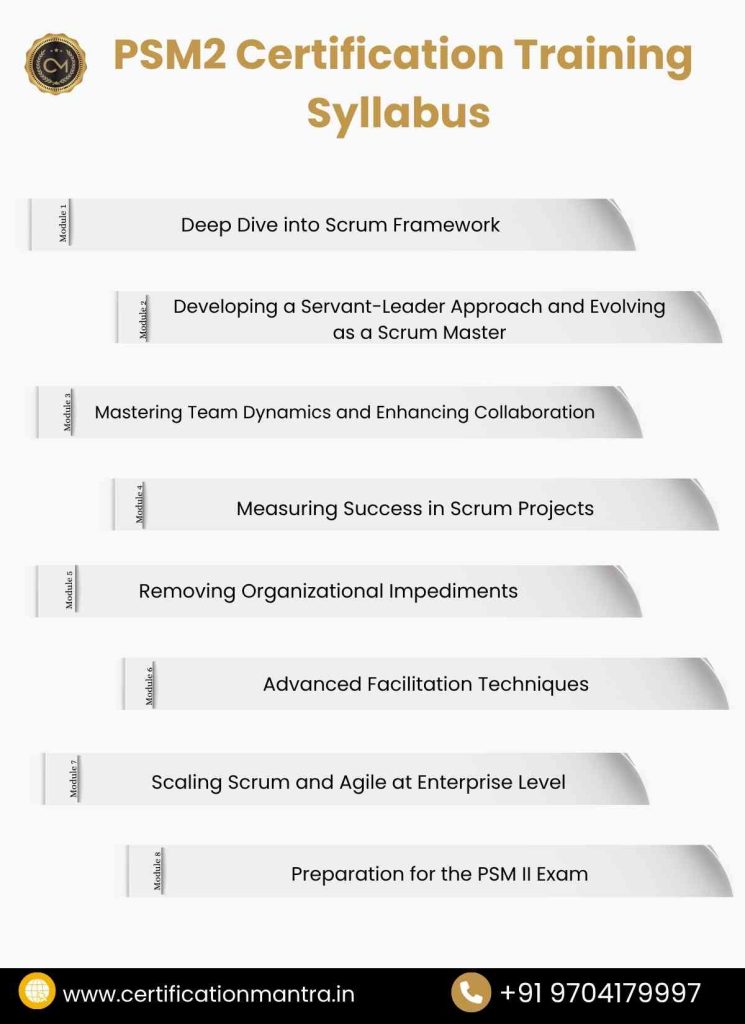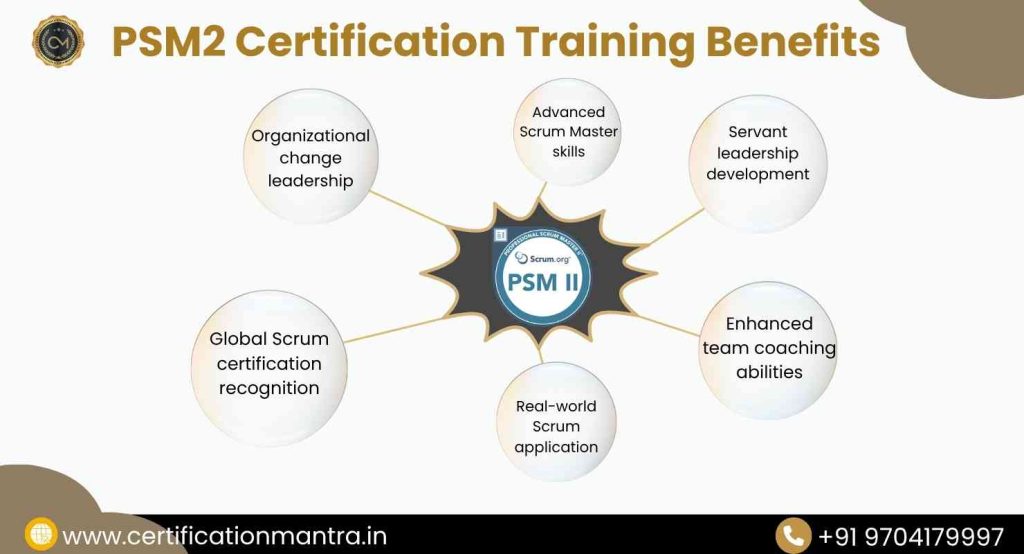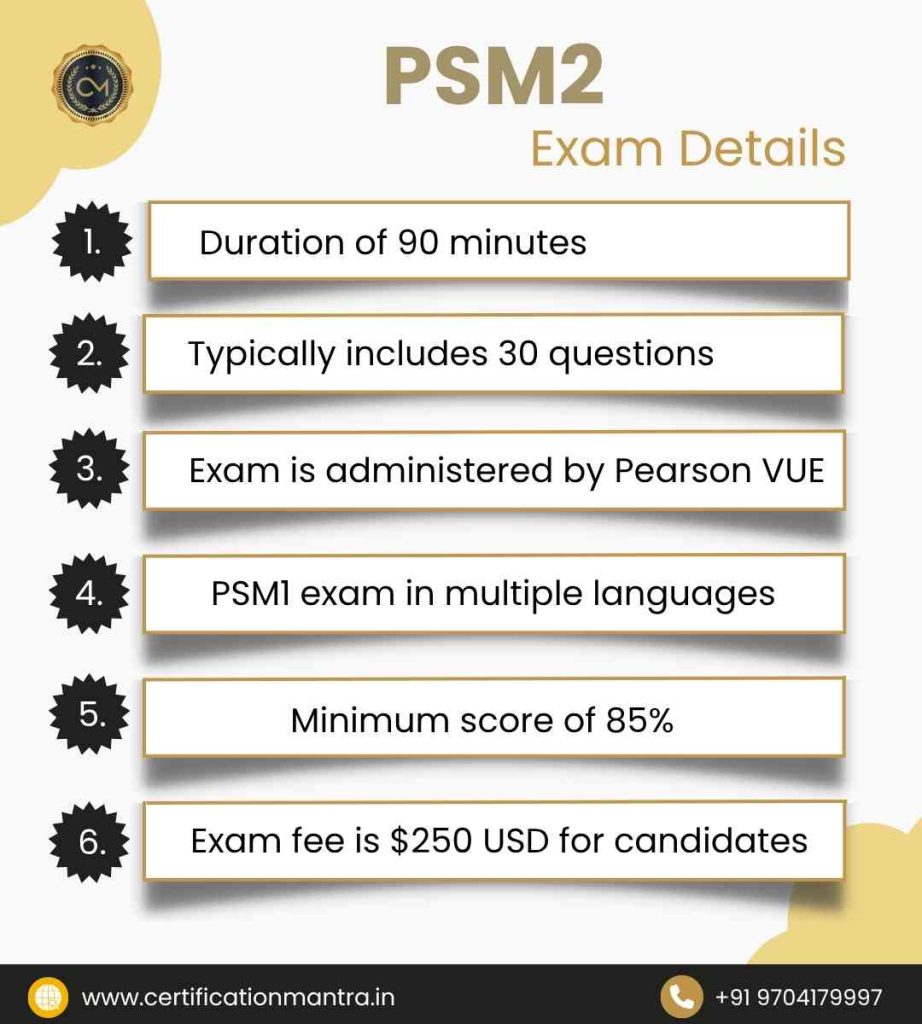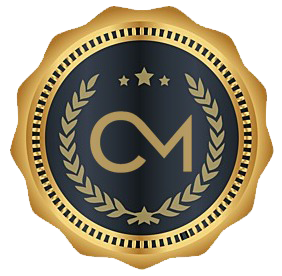PSM2 Certification Training in Hyderabad
100% Pass for Professional Scrum Master Certification Exam in First Attempt only.
Next Batch: 25 NOV 2025
100% Pass Guarantee
We guarantee your success! With our unique methodologies and constant assessment
Crack in First Attempt
We don't cut any corners when it comes to providing you the best training.
Certified Trainers
All our trainers are certified and have a proven track record of providing high-quality training.

Key Highlights of PSM2 Certification
- Comprehensive Syllabus
- Real-world Experience
- Guaranteed Success
- Lifetime access to recorded lectures and materials
- High-quality Lectures
- Learn at Your Convenience
- 100 % Job Assistance
- Advanced roles of the Scrum Master beyond basic facilitation
- Clarifying misconceptions about Scrum theory and principles
- Exploring Scrum values, pillars, and empirical process control
- Applying Scrum in complex, real-world environments
- Understanding the servant-leader stance in agile teams
- Emotional intelligence and coaching skills for Scrum Masters
- Influencing organizational change and building agile culture
- Transitioning from team facilitator to organizational coach
- Handling conflicts and facilitating collaboration within teams
- Identifying team dysfunctions and resolving them effectively
- Coaching the Product Owner and Development Team
- Managing dependencies and cross-functional interactions
- Key performance indicators (KPIs) in Scrum
- Inspect and Adapt cycles: Sprint Retrospective and Reviews
- Value delivery over activity-based metrics
- Driving business agility through metrics
- Recognizing and addressing organizational-level challenges
- Influencing stakeholders for system-wide agility
- Coaching leadership for Scrum adoption and scale
- Building a culture of continuous improvement
- Leading high-impact Scrum Events
- Facilitating product discovery workshops
- Applying Liberating Structures in Scrum
- Managing stakeholder expectations
- Introduction to scaling frameworks (e.g., Nexus, SAFe, LeSS)
- Role of Scrum Master in large teams and distributed teams
- Coaching multiple teams towards shared goals
- Applying systems thinking in scaled Scrum environments
- Exam pattern, duration, and passing criteria (85% score)
- Practice questions aligned with real-time scenarios
- Mock tests, live discussions, and feedback sessions

What Is PSM 2 Professional Scrum Master Certification Exam
This Professional Scrum Master (PSM II) certificate validates your knowledge about the Scrum framework and the Scrum Master accountability, and the best way to implement Scrum.
PSM II is widely recognized by the business community as a certificate that shows an essential level of Scrum competence.
As PSM II certified holders, you’ve demonstrated that you are knowledgeable about Scrum as defined in The Scrum Guide and know how to implement Scrum within Scrum Teams. PSM II holders can use the same terminology and approach to Scrum.
Scrum is an agile framework that helps solve complex problems using adaptable solutions.
Achieving Professional Scrum Master Certification can help you understand and apply Scrum to tackle complex problems, including creating new processes, products and solutions.
PSM 2 Certification Importance
- It demonstrates that you have a deep understanding of Scrum and can effectively apply its principles in complex, real-world scenarios.
- It helps you grow into a true servant-leader who supports and empowers agile teams.
- It adds credibility to your profile and sets you apart from other Scrum professionals in the industry.
- You’ll improve your ability to coach team members, guide stakeholders, and run Scrum events effectively.
- It opens up career growth opportunities into senior roles like Agile Coach or Senior Scrum Master.
- It prepares you to handle real-time challenges such as team conflicts, stakeholder resistance, and organizational blockers.
- It boosts your chances of getting better job offers and higher salary packages, especially in agile-driven markets like Hyderabad.
- You’ll be ready to work in large-scale agile setups and manage multiple Scrum teams confidently.
- It gives you the confidence to drive organizational change and contribute to agile transformation at a higher level.

Practical Training
Advanced Syllabus
Best Stimulations
PSM 2 Certification Levels
There are three levels of certification Scrum.org provides through Professional Scrum Master (PSM I, PSM II, and PSM III). Also, there are three different levels to Professional Scrum Master Certifications, which are described as follows:
Foundational (PSM I)
Professional Scrum Master ( PSM I) certificate validates your knowledge about the Scrum framework and the Scrum Master obligations and how to use Scrum.
Intermediate (PSM II)
Show Your Expertise Skills in Scrum along with The Scrum Master Accountabilities The Professional Scrum Master II ( PSM II) certificate validates your abilities.
Advanced (PSM III)
Professional Scrum Master III ( PSM III) certificate validates your understanding of how to implement Scrum, Scrum practices and the Scrum Values.

Why Choose us for PSM 2 Certification Course
Hands on Practice
Hands-on lab exercises with detailed answers.
Best Support
Support provided by our friendly support team
Real-life Case Studies
Realistic and relevant case studies that you can relate to your own projects.
Highly Qualified
Expert team of highly qualified faculty members.
Guidance from Experienced Instructors
Guidance throughout the entire course from highly experienced instructors who are there to help you at every step of the way.
PSM 2 Certification Training Career Growth
- Opens up advanced career roles such as Senior Scrum Master, Agile Coach, or Agile Delivery Manager.
- Makes you a strong candidate for leadership roles in agile project environments.
- Enhances your ability to work with multiple teams, departments, and stakeholders in complex setups.
- Boosts your chances of getting placed in top MNCs and agile organizations across Hyderabad and globally.
- Enhances your market value by offering better salary prospects and stronger job stability.
- Helps you shift from team-level facilitation to organization-wide agile coaching and mentoring.
- Builds your confidence to apply Scrum in real-world, high-pressure, and scaled agile environments.
- Gives you recognition as a trusted advisor or change agent in your company’s agile transformation.
- Opens doors to consulting and freelance opportunities in agile training and coaching.
- Helps you build a long-term, sustainable career in the agile and project management domain.

PSM 2 Certification Training Objectives
- Gain a deeper understanding of Scrum principles, values, and real-world application.
- Learn how to lead Scrum Teams effectively as a servant-leader, not just a facilitator.
- Improve your ability to coach teams, Product Owners, and stakeholders.
- Understand how to resolve team conflicts and build high-performing agile teams.
- Strengthen your decision-making in complex Scrum scenarios using practical thinking.
- Master the skills needed to remove organizational impediments and drive team success.
- Learn how to influence leadership and support agile transformation at all levels.
- Prepare thoroughly for the PSM 2 certification exam with hands-on scenarios and mock tests.
- Develop facilitation skills for leading Scrum events and agile workshops with confidence.
- Gain clarity on your role in scaled Scrum environments and large agile teams.
- You should have a solid understanding of the Scrum framework and its practical applications in the real world.
- Prior experience working as a Scrum Master or in a Scrum Team is highly recommended.
- It’s ideal to hold the PSM I (Professional Scrum Master I) certification before attempting PSM 2.
- Familiarity with Scrum roles, events, and artifacts is essential for grasping advanced concepts.
- You must be comfortable applying Scrum in complex team or organizational settings.
- Strong communication, facilitation, and coaching skills will be beneficial during the training.
- A mindset open to continuous learning and servant leadership is crucial.
Who Can Attend PSM 2 Certification
- Experienced Scrum Masters aiming to advance their knowledge and inspire high-performing teams
- Agile Coaches and Mentors aiming to guide teams through complex transformations
- Team Leads and Project Managers working in agile or hybrid project environments
- Product Owners and Developers looking to understand advanced Scrum practices
- Professionals with PSM I Certification who are ready for the next step in their Scrum journey
- Agile professionals looking to strengthen their coaching, facilitation, and servant leadership capabilities
- IT professionals and consultants who help organizations adopt and scale Scrum
- Anyone looking to strengthen their profile for senior agile roles or global opportunities
How to Become PSM 2 Certified?
- Develop a strong grasp of Scrum by working in real-world projects, preferably as a Scrum Master.
- Pass the PSM I certification exam to establish a solid foundation in Scrum principles.
- Enroll in a PSM 2 certification training program like CertificationMantra’s course in Hyderabad for in-depth learning and expert guidance.
- Study the Scrum Guide, practice with mock exams, and focus on real-world agile scenarios to sharpen your skills.
- Sign up for the PSM 2 exam on Scrum.org, score 85% or above, and become a certified Professional Scrum Master™ II.
PSM 2 Certification Exam Format
PSM II exam is an intermediate-level test that has 30 questions, which consist of multiple choice questions, multiple answers and true/false.
To pass this test, it will have 90 minutes. To succeed, it is required to score at least 85%.
However, the price of taking the PSM2 Professional Scrum Master I Exam is $250 USD for each test and is available solely in the English language.

PSM 2 Certification Exam Retake Policy
There are many applicants who have questions regarding the Exam retake policy. Let’s look at the cases that are defined –
You’ve officially failed the test if you do not achieve 85% or higher.
There are no limitations on the number of times you can take the test so long as you pay for the exam.
Scrum.org. permits you to pass the PSM I exam at no cost for your first two tests within 14 days of receiving your key.
Any subsequent attempt is subject to a fee.
PSM certification is valid for a lifetime and is not required to be renewed.
PSM 2 Certification Exam Cancellation Policy
To cancel an order to get an exchange of the Scrum.org exam password, you must fulfil the following requirements:
- The password should not be used
- The order must be made within the last 60 days. No cancellation or refund can be processed for any order within 60 days of the purchase date.
You may cancel the entire order if the conditions above are satisfied for orders that are single and have several passwords.
For orders that are single and have more than one password, you can cancel the entire order if the conditions above are satisfied.
If you want to cancel passwords for individual users in an order in bulk or volume (for example that, you placed an order for 15 passwords, but you want to end three),
Scrum.org is only allowed to issue refunds for the individual passwords of an order in bulk within a week from the date on which the purchase was made.
If the above requirements are satisfied, and you wish to begin the refund process, Please forward the following details to support@scrum.org.
- The Order ID number to the password that has not been used or the password for the assessment that was not used.
- The reason for which you’re asking an amount of money back.
- If the purchase were made via an email address other than the one you used to place the order, It would be beneficial to mention the email address used to make the purchase.
After being initiated , the refund can require a few days for processing before it’s visible in the associated account.
Scrum.org does not take responsibility for any transaction charges you pay to your bank or credit card, nor for any variation in exchange rates between the date you purchased and the date that the refund is made.
What Our Students Have to Say
Frequently Asked Questions

PSM 2 is an advanced-level certification from Scrum.org that validates your ability to apply Scrum in real-world, complex scenarios. It focuses on deepening your understanding of Scrum and developing your servant-leader mindset.
PSM 1 tests your basic knowledge of Scrum, while PSM 2 evaluates your real-time application, leadership skills, and ability to handle advanced Scrum challenges. It’s more scenario-based and strategic.
It’s not a hard requirement, but highly recommended. PSM 1 builds your foundation, which makes it easier to grasp the advanced concepts in PSM 2.
Yes, you can refer to materials during the exam, as it is open book. However, due to the complexity of questions, relying on materials during the exam may not be enough without thorough preparation.
The exam consists of 30 questions, primarily focused on real-world scenarios. You’ll be expected to apply Scrum knowledge to complex team and organizational situations.
You need at least 85% to pass, which means you must answer at least 26 out of 30 questions correctly. Accuracy matters more than speed.
You’ll have 90 minutes to finish the exam. Time management is essential as some questions may take longer due to their complexity.
The exam consists of multiple-choice, multiple-answer, and true/false questions. All questions are based on real-life Scrum applications.
Absolutely. It’s a globally respected credential issued by Scrum.org and is valued by top companies worldwide.
You can aim for roles like Senior Scrum Master, Agile Coach, Agile Delivery Manager, or even Agile Transformation Consultant.
Each attempt for the exam costs USD 250. It’s a one-time fee without any renewal charges since the certification is valid for life.
You can register directly through Scrum.org. Once you purchase the exam, you’ll receive a link to attempt it online at your convenience.
No, the certification does not expire — it’s valid for a lifetime. You don’t have to renew it or pay any annual maintenance fees.
Yes, the exam is fully online and can be taken from anywhere with a stable internet connection.
If you don’t pass the exam, you’ll need to buy another attempt separately. There’s no waiting period, but preparation before reattempting is crucial.
Not at all. The focus is purely on Scrum principles, leadership, and team dynamics—no programming involved.
Yes, if you work in agile environments or manage teams, PSM 2 is relevant regardless of your technical background.
The Scrum Guide is a must-read. Practice assessments, real-life scenarios, and participation in Scrum forums are also helpful.
Most professionals spend 2 to 4 weeks preparing, depending on their experience. Consistent study and mock practice help a lot.
Yes, Scrum.org issues a digital badge along with your certificate, which you can share on LinkedIn and your resume.
Absolutely! Training providers like CertificationMantra offer expert-led PSM 2 training tailored to professionals in Hyderabad.
No, it’s optional. But training gives you real-world insights and prepares you better for scenario-based questions.
It focuses on leadership, coaching techniques, stakeholder management, and applying Scrum in complex situations.
Yes, certified professionals often see better salary offers and promotions due to their advanced Scrum capabilities.
opt for scenario-based mock tests that closely mirror the actual exam questions. These will sharpen your thinking and decision-making.
Technically yes, but the exam is time-bound and designed to test your understanding, not just your reading ability.
Yes, it’s one of the more advanced certifications and demands deeper understanding and real-time application of Scrum.
PSM 2 is Scrum-specific and focuses on mastering one framework, while others cover broader agile methodologies or scaling.
Yes, several LinkedIn groups, forums, and Reddit threads help candidates share resources and experiences.
PSM 2 is highly respected, vendor-neutral, and exam-focused—making it a strong credential backed by Scrum.org’s reputation.
Other Certification Trainings we offer
- AZ 900 Certification Training
- AZ 104 Certification Training
- AZ 204 Certification Training
- DP 900 Certification Training
- DP 203 Certification Training
- PL300 Certification Training
- PSM1 Certification Training
- ITIL v4 Certification Training
- Salesforce Admin Certification Training
- Snowflake Core Certification Training
- ISTQB Certification Training

